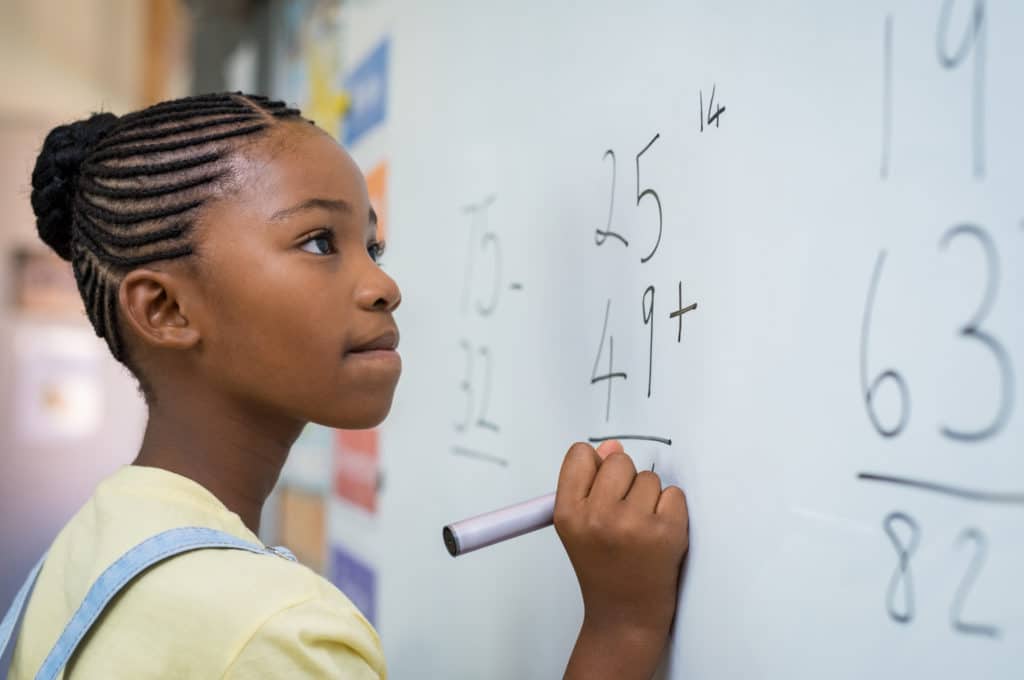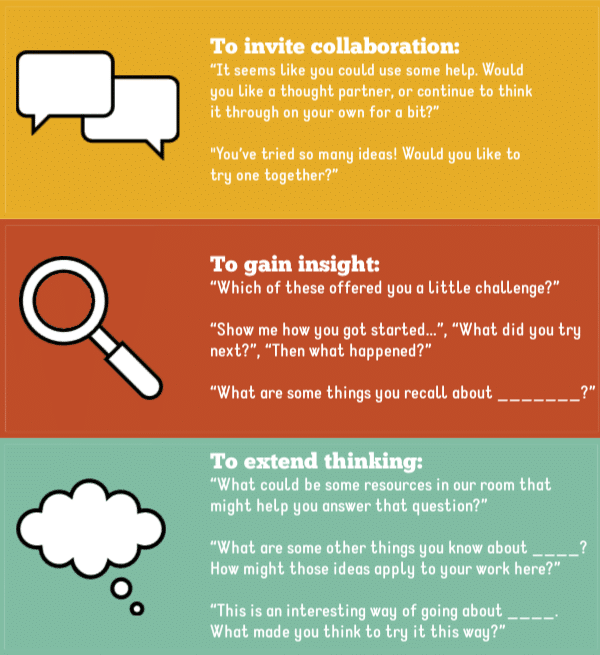
“If there is no struggle, there is no progress.”
– Frederick Douglass
This famous quote, printed on bright pink cardstock and posted above the whiteboard of a third grade classroom, stood out during a recent school observation. I tend to see a lot of these on walls during observations—words of wisdom laminated and carefully hung, intended to make the learning environment more beautiful or inspiring, but seldom referred to by either teachers or students. In this room, though, it became clear that these words represented something deeper. In this room, “struggle” emerged as something expected, fruitful, worthy of celebration—a kind of community ethos that seemed to fuel the interaction and learning therein.
During this math lesson, students were practicing calculating perimeter and area of rectangles. As I looked around the room, I saw students actively, purposefully engaged with a variety of materials and peers. A pair of students collected manipulatives from one area of the room to bring back to the other pair of students in their small group, who were busy debating “alternative strategies.” A few other students nearby worked independently with graph paper and markers, occasionally looking at each other’s work to offer feedback or kudos. At another table, I saw partners pointing to an anchor chart the class had created moments earlier with tips for distinguishing between the two types of measurement. I saw a student scratching her head one second, and a moment later calling out her discoveries to anyone (or no one at all): “Hey! I figured it out!” A child next to me flipped back through his math notebook, talking to himself as he patiently scanned pages preceding the day’s lesson: “Another strategy could be…”
Children were experiencing “struggle” as they worked, and seemed happier, and even more focused, for it.
At their core, great teachers hope to instill skills and strategies that will empower students to thrive in their schooling (and life). We impart soliloquies about the importance of “grit” and the power of “growth mindsets,” in the hopes that these keys for lifelong learning will manifest in our students. In this classroom, I didn’t hear these words or see them posted on walls. What I saw was gritty learners embracing challenge. What I heard was growth-oriented interactions among 8- and 9-year-olds who were thoughtfully attuned to each other and their work.
Often more than words, our actions have the power to create conditions where grit and growth mindsets take root. Our actions have the power to facilitate learning environments which guide students’ developmentally appropriate practice and the incremental mastery of complex competencies that lifelong learners espouse, such as assertiveness, responsibility, and perseverance.
To foster challenging learning experiences, where struggle and progress go hand in hand, remember three keys:
In order for learners to experience productive struggle they need to be presented with appropriately challenging work. Lev Vygotsky’s concept of Zone of Proximal Development (ZPD)—the difference between what a learner can do without help and what they can’t do—is an essential factor for effective lesson design and goal-setting with students. When students work within their ZPD they can leverage previous knowledge, skills, and strategies to advance their learning. To ensure all students are working within their ZPD most of the time, teachers must create learning experiences that are flexible enough to accommodate a wide range of abilities and needs.
One strategy that can be used to achieve this flexibility is to offer students choices in their learning. In the Responsive Classroom approach teachers use Academic Choice, a practice to structure lessons that offer students choices in content or process, or sometimes both. In this Academic Choice math lesson, students had choice in the process—to work alone or with a partner. The teacher did not offer a choice in the content—everyone was practicing calculating perimeter and area of rectangles. Offering choice, like this teacher did, is one way teachers can accommodate a breadth of learning needs and help all learners experience developmentally appropriate challenge and accomplishment.
Begin by helping students envision what fruitful struggle might entail. Help them anticipate potential challenges and what “getting stuck” might feel like. Then, invite students to brainstorm resources they could turn to when challenged. During a math lesson, this might sound something like:
“As skillful measurers, you are getting more and more comfortable with calculating the area and perimeter of rectangles. I’ve noticed ways you are all building on various skills and strategies to muster through new challenges, like creating visuals on graph paper and using manipulatives to compute.”
“Before we get started, let’s imagine some challenges that might come up during our practice today, and brainstorm resources people could use to get through them. For example, a common wondering might be, ‘Do I need to calculate area or perimeter here?’ What might be some resources that could help someone in that situation?”
Teach students how to recognize and utilize resources around them, such as:
Sometimes, despite our best efforts to teach perseverance and grit, we actually interrupt students’ practice of it. Lots of teachers have a tendency to rush in to “save” a child from challenge, maybe by hinting at the answer, or interjecting an “idea” a student could try instead. Teachers need to remember that appropriately challenging work should be challenging. In order for students to persevere, they must learn to navigate struggle.
Years ago on a bright spring afternoon one of my wise kindergarten students taught me a key lesson: the importance of being a careful coach.
Our exchange happened, ironically, during a lesson designed to help students practice a repertoire of problem-solving strategies, independently, ahead of the year-end math assessment. The room buzzed with purpose and focused attention, all 28 kids working independently and energetically. As students worked I traveled around the room, reinforcing the many skills and creative strategies I noticed them using. As one child finished telling me about their inventive use of graph paper, I noticed Kevin across the room peering skeptically at his manipulatives, his gaze shifting up to a nearby anchor chart and back again. Assuming Kevin was in over his head, and without a second thought, I rushed over to save him from what I deemed to be imminent frustration—or worse, failure. The interaction went something like this:
Me: (scurrying over on my knees, dodging kids and materials strewn about the carpet before landing, a little out of breath, at Kevin’s side) “Hey Kevin! Looks like you’re working so hard over here… Have you tried sorting the pieces in a different way? Maybe by size rather than color?”
Kevin: (after a pause, fixing his eyes on the chart ahead of him and sighing a notably irritated sigh) “But Ms. Lindsey, I wasn’t finished thinking about that for myself yet!”
In a well-intended rush to prevent discomfort, I had robbed Kevin of his hard-earned discovery.
After dismissal that afternoon, I recommitted to pausing my teacher assumptions and approaching my coaching conversations with greater curiosity. To support my growth, I typed up some open-ended prompts and taped them to the back of my clipboard:

It isn’t easy to create conditions for students to take ownership of their learning, but it doesn’t have to be all that hard either. You can start by reflecting on your own teaching style, current teaching practices, and potential strengths and opportunities you have when facilitating student-directed learning. To gauge where to begin, try answering the following questions for yourself:
It can be challenging to help students see missteps and misconceptions as imperative parts of learning. If your students are struggling with struggle, try revealing the value of mistakes through guided reflection prompts that help kids articulate the outcomes of challenge and perseverance:
Written by Lindsey Lynch, RC Consulting Teacher and Educational Consultant